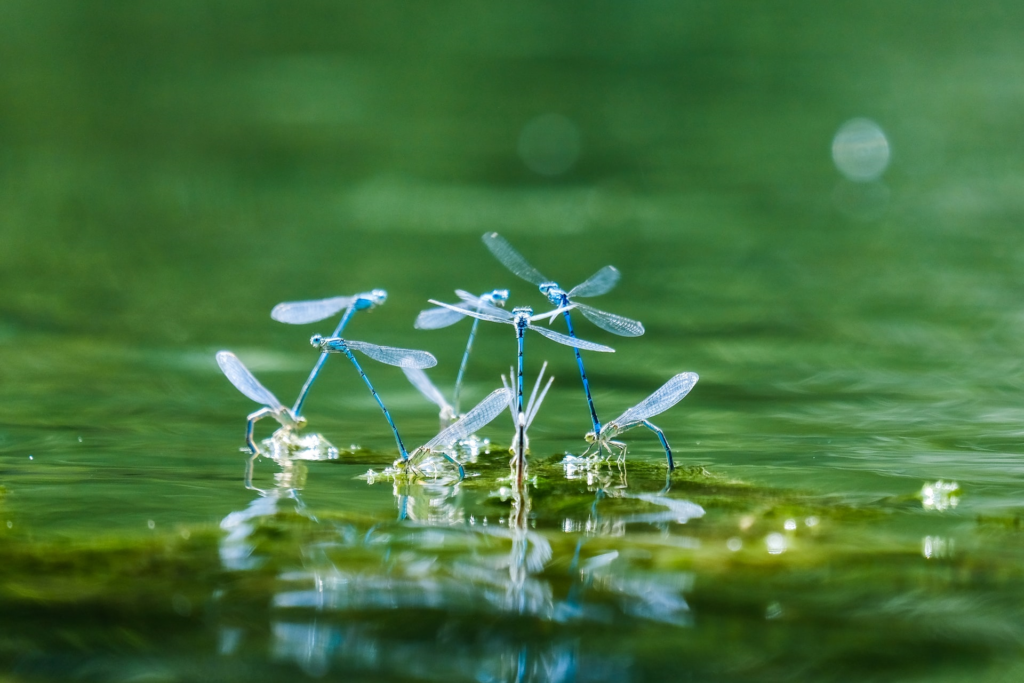Animal Adaptations
Many plants and animals have adapted to the freshwater biome and could not survive in water having a higher salt concentration. As this ecosystem covers a vast portion of the world, the animal life found can vary considerably.
Fish are able to obtain oxygen through their gills. Fish such as trout have adapted to living in rivers and streams where the water is cooler, clearer and has a higher oxygen level. At the mouth of these water sources, the sediments create a more murky environment with lower oxygen levels and fish such as catfish and carp have adapted to exist in these areas.
There are three zones in lakes and ponds:
The littoral zone (the topmost and warmest is home to snails, clams, insects, crustaceans, fishes and amphibians and the eggs and larvae of dragonflies and midges). These resources provide food for turtles, snakes and ducks.
The limnetic zone is close to the surface and consequently receives a good deal of light. This zone contains a variety of freshwater fish.
The profundal zone is very dense and cold, with little light penetrating this region. Only heterotrophs (animals that eat dead organisms) are found in this region
Mammals (badgers, otters, mink) live near water and are capable of swimming to catch their main food source, fish.
Amphibians and reptiles (toads, frogs, alligators, crocodiles, salamanders and newts start life underwater as eggs and tadpoles, and then move to ground as adults.
Insects such as skaters, water beetles, mosquitoes and dragonflies can skim over the surface of ponds, playing a critical role in the food supply for other animals. Some spiders can actually take a bubble of air with them underwater.
Many species of ducks, geese and swans also call the freshwater biome their home, feeding on a number of different items including fish, while wading birds such as herons and egrets wander through the mud shallows searching for insects.
Manatees have adapted to survive in warm water and migrate south. Some have found the warm water near power plants, and consequently do not have to migrate.
Beavers shape their environment more than most other animal species on Earth, utilizing their ever-growing teeth to cut down trees and plants to create dams to create their dens. Their actions are not always appreciated by nearby humans, but they are vital to the ecology, causing a build-up of water which in turn creates a new wetland. Beavers also help to purify water because the sediments and any toxins are trapped behind the dam.
Plant Adaptations
Various species of aquatic plants and algae have also adapted to exist in the wider parts of rivers and streams where the water is clear enough to allow sunlight to penetrate.
Zooplankton are microscopic organisms that live suspended in the water environment, moving via convection or wind-induced currents. Plankton live for only a short period of time; when they die they fall into the deep-water and provide food for larger animals.
Wetlands contain standing water and plant species that have adapted to this very moist and humid environment include pond lilies, cattails, sedges, tamarack and black spruce, cypress and gum.
Effects of Global Warming on Freshwater Ecosystems
- As in other parts of the world, global warming has affected the cover of ice found on the Great Lakes, a vast 94,000 square mile lake system. The ice cover has declined 30% since the 1970’s, causing a higher rate of evaporation and lower water levels. The very ecology of the water will change as the temperatures warm, reducing the seasonal mixing vital to the replenishment of oxygen. This will mean the loss of zooplankton and phytoplankton that are essential to the aquatic food chain, starting with fish, all the way up to humans.
- Wetlands and Coastal Ecosystems will decline and in turn migratory bird populations will be tragically affected, along with fish populations in these areas.
- Heat waves will increase in number of days above 90ºF., putting human health at risk.
- A long-term study of the world’s largest freshwater lake, Lake Baikal in Siberia has revealed “significant warming of surface waters and long-term changes in the food web of the world’s largest, most ancient lake”, with a 300% increase in chlorophyll and 335% increase in zooplankton grazers.
- The melting of permafrost in the world’s colder regions allows layers of dead plant material and other organic compounds to decay, causing an increase in carbon dioxide and methane gas, which in turn releases more greenhouse gases into the atmosphere.
- Ice caps such as the Quelccaya in Peru are melting at such a fast rate that it is expected to disappear by 2100, leaving the local people without a source of drinking water and electricity.




